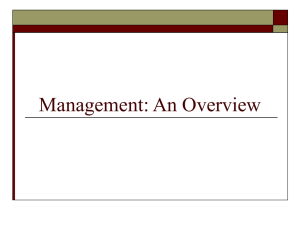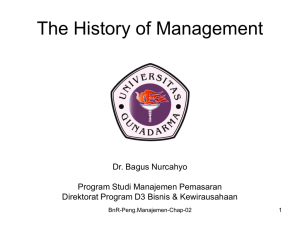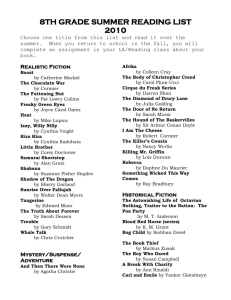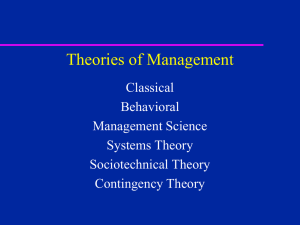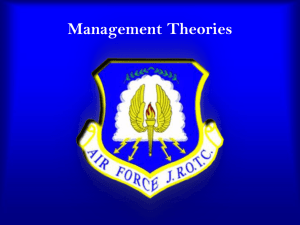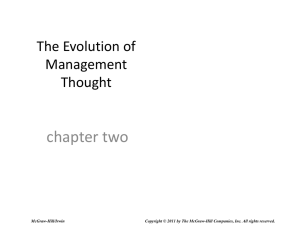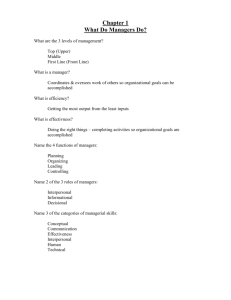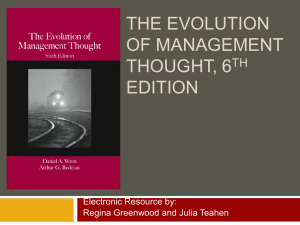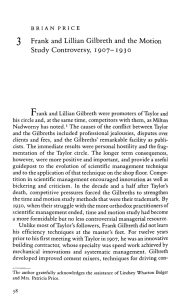Management History - challengerhospitality
advertisement
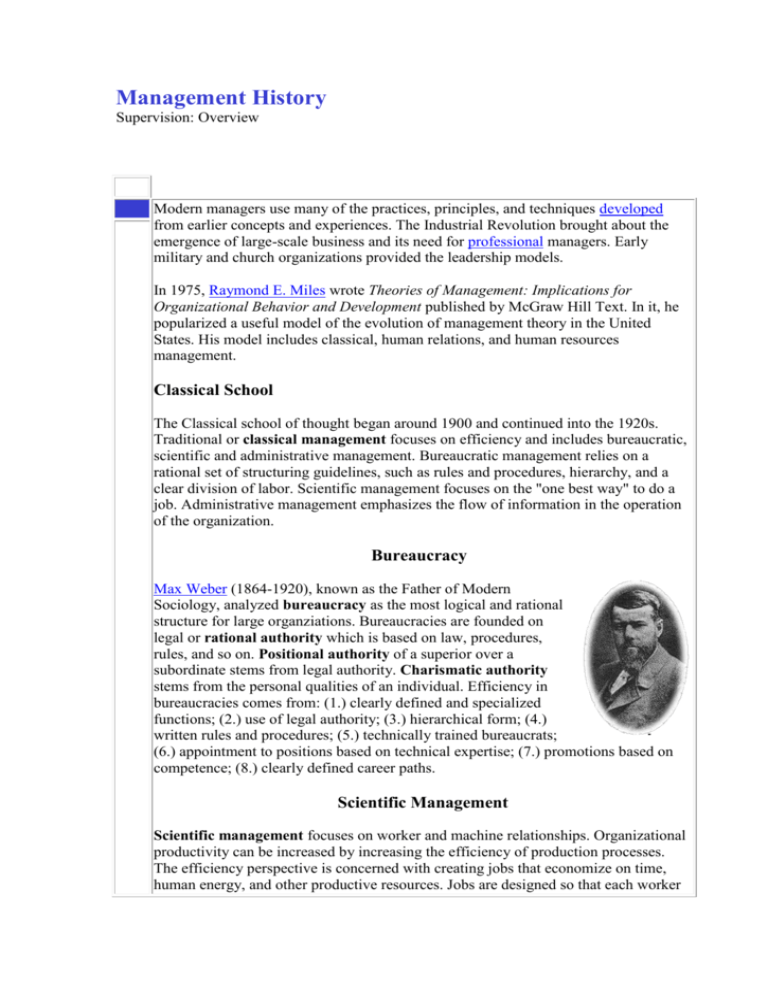
Management History Supervision: Overview Modern managers use many of the practices, principles, and techniques developed from earlier concepts and experiences. The Industrial Revolution brought about the emergence of large-scale business and its need for professional managers. Early military and church organizations provided the leadership models. In 1975, Raymond E. Miles wrote Theories of Management: Implications for Organizational Behavior and Development published by McGraw Hill Text. In it, he popularized a useful model of the evolution of management theory in the United States. His model includes classical, human relations, and human resources management. Classical School The Classical school of thought began around 1900 and continued into the 1920s. Traditional or classical management focuses on efficiency and includes bureaucratic, scientific and administrative management. Bureaucratic management relies on a rational set of structuring guidelines, such as rules and procedures, hierarchy, and a clear division of labor. Scientific management focuses on the "one best way" to do a job. Administrative management emphasizes the flow of information in the operation of the organization. Bureaucracy Max Weber (1864-1920), known as the Father of Modern Sociology, analyzed bureaucracy as the most logical and rational structure for large organziations. Bureaucracies are founded on legal or rational authority which is based on law, procedures, rules, and so on. Positional authority of a superior over a subordinate stems from legal authority. Charismatic authority stems from the personal qualities of an individual. Efficiency in bureaucracies comes from: (1.) clearly defined and specialized functions; (2.) use of legal authority; (3.) hierarchical form; (4.) written rules and procedures; (5.) technically trained bureaucrats; (6.) appointment to positions based on technical expertise; (7.) promotions based on competence; (8.) clearly defined career paths. Scientific Management Scientific management focuses on worker and machine relationships. Organizational productivity can be increased by increasing the efficiency of production processes. The efficiency perspective is concerned with creating jobs that economize on time, human energy, and other productive resources. Jobs are designed so that each worker has a specified, well controlled task that can be performed as instructed. Specific procedures and methods for each job must be followed with no exceptions. Frederick Taylor (1856-1915) Many of Frederick Taylor's definitive studies were performed at Bethlehem Steel Company in Pittsburgh. To improve productivity, Taylor examined the time and motion details of a job, developed a better method for performing that job, and trained the worker. Furthermore, Taylor offered a piece rate that increased as workers produced more. In 1911, Frederick Taylor, known as the Father of Scientific Management, published Principles of Scientific Management in which he proposed work methods designed to increase worker productivity. One of his famous experiments had to do with increasing the output of a worker loading pig iron to a rail car. Taylor broke the job down into its smallest constituent movements, timing each one with a stopwatch. The job was redesigned with a reduced number of motions as well as effort and the risk of error. Rest periods of specific interval and duration and a differential pay scale were used to improve the output. With scientific management, Taylor increased the worker's output from 12 to 47 tons per day! The Taylor model gave rise to dramatic productivity increases. Frank (1868-1924) and Lillian (1878-1972) Gilbreth Frank and Lillian Gilbreth emphasized method by focusing on identifying the elemental motions in work, the way these motions were combined to form methods of operation, and the basic time each motion took. They believed it was possible to design work methods whose times could be estimated in advance, rather than relying upon observation-based time studies. Frank Gilbreth, known as the Father of Time and Motion Studies, filmed individual physical labor movements. This enabled the manager to break down a job into its component parts and streamline the process. His wife, Lillian Gilbreth, was a psychologist and author of The Psychology of Work. In 1911 Frank Gilbreth wrote Motion Study and in 1919 the couple wrote Applied Motion Study. Frank and Lillian had 12 children. Two of their children, Frank B. Gilbreth, Jr. and Ernestine Gilbreth Careyone, wrote their story, Cheaper by the Dozen. One of Frank Gilbreth's first studies concerned bricklaying. (He had worked as an apprentice bricklayer.) He designed and patented special scaffolding to reduce the bending and reaching which increased output over 100 per cent. However, unions resisted his improvements, and most workers persisted in using the old, fatiguing methods. The Gilbreths believed that there was one best way to perform an operation. However, this "one best way" could be replaced when a better way was discovered. The Gilbreths defined motion study as dividing work into the most fundamental elements possible, studying those elements separately and in relation to one another; and from these studied elements, when timed, building methods of least waste. They defined time study as a searching scientific analysis of methods and equipment used or planned in doing a piece of work, development in practical detail of the best way of doing it, and determination of the time required. The Gilbreths drew symbols on operator charts to represent various elements of a task such as search, select, grasp, transport, hold, delay, and others. They called these graphical symbols "therbligs" (Gilbreths spelled backwards). Henry Gantt (1861-1919) Henry Gantt developed the Gantt chart, which is used for scheduling multiple overlapping tasks over a time period. He focused on motivational schemes, emphasizing the greater effectiveness of rewards for good work (rather than penalties for poor work). He developed a pay incentive system with a guaranteed minimum wage and bonus systems for people on fixed wages. Also, Gantt focused on the importance of the qualities of leadership and management skills in building effective industrial organizations. Administrative Management Administrative management emphasizes the manager and the functions of management. Henri Fayol (1841--1925), known as the Father of Modern Management, was a French industrialist who developed a framework for studying management. He wrote General and Industrial Management. His five functions of managers were plan, organize, command, coordinate, and control. His fourteen principles of management included division of work, authority and responsibility, discipline, unity of command, unity of direction, subordination of individual interests to general interests, renumeration of personnel, centralization, scalar chain, order, equity, stability of tenure of personnel, initiative, and esprit de corps (union is strength). Mary Parker Follett's concepts included the universal goal, the universal principle, and the Law of the Situation. The universal goal of organizations is an integration of individual effort into a synergistic whole. The universal principle is a circular or reciprocal response emphasizing feedback to the sender (the concept of two-way communications). Law of the Situation emphasizes that there is no one best way to do anything, but that it all depends on the situation. Human Relations School Behavioral or human relations management emerged in the 1920s and dealt with the human aspects of organizations. It has been referred to as the neoclassical school because it was initially a reaction to the shortcomings of the classical approaches to management. The human relations movement began with the Hawthorne Studies which were conducted from 1924 to 1933 at the Hawthorne Plant of the Western Electric Company in Cicero, Illinois. The Hawthorne Studies Harvard Business School researchers, T.N. Whitehead, Elton Mayo, and George Homans, were led by Fritz Roethlisberger. Elton Mayo, known as the Father of the Hawthorne Studies, identified the Hawthorne Effect or the bias that occurs when people know that they are being studied. The Hawthorne Studies are significant because they demonstrated the important influence of human factors on worker productivity. There were four major phases to the Hawthorne Studies: the illumination experiments, the relay assembly group experiments, the interviewing program, and the bank wiring group studies. The intent of these studies was to determine the effect of working conditions on productivity. The illumination experiments tried to determine whether better lighting would lead to increased productivity. Both the control group and the experimental group of female employees produced more whether the lights were turned up or down. It was discovered that this increased productivity was a result of the attention received by the group. In the relay assembly group experiments, six female employees worked in a special, separate area; were given breaks and had the freedom to talk; and were continuously observed by a researcher who served as the supervisor. The supervisor consulted the employees prior to any change. The bank wiring group studies were analyzed thoroughly by Homans and were included in his now classic book, The Human Group. The bank wiring groups involved fourteen male employees and were similar to the relay assembly group experiments, except that there was no change of supervision. Again, in the relay and bank wiring phases, productivity increased and was attributed to group dynamics. The conclusion was that there was no cause-and-effect relationship between working conditions and productivity. Worker attitude was found to be important. An extensive employee interviewing program of 21,000 interviews was conducted to determine employee attitudes toward the company and their jobs. As a major outcome of these interviews, supervisors learned that an employee's complaint frequently is a symptom of some underlying problem on the job, at home, or in the person's past. Chester Barnard (1886-1961) When Chester Barnard retired as the CEO of New Jersey Bell Telephone, he recorded his insights about management in his book, Functions of the Executive. It outlined the legitimacy of the supervisor's directives and the extent of the subordinates' acceptance. He developed the concepts of strategic planning and the acceptance theory of authority. Strategic planning is the formulation of major plans or strategies, which guide the organization in pursuit of major objectives. Barnard taught that the three top functions of the executive were to (l) establish and maintain an effective communication system, (2) hire and retain effective personnel, and (3) motivate those personnel. His Acceptance Theory of Authority states that managers only have as much authority as employees allow them to have. The acceptance theory of authority suggests that authority flows downward but depends on acceptance by the subordinate. The acceptance of authority depends on four conditions. (1.) Employees must understand what the manager wants them to do. (2.) Employees must be able to comply with the directive. (3.) Employees must think that the directive is in keeping with organizational objectives. (4.) Employees must think that the directive is not contrary to their personal goals. Barnard believed that each person has a zone of indifference or a range within each individual in which he or she would willingly accept orders without consciously questioning authority. It was up to the organization to provide sufficient inducements to broaden each employee's zone of indifference so that the manager's orders would be obeyed. Human Resources School Beginning in the early 1950s, the human resources school represented a substantial progression from human relations. The behavioral approach did not always increase productivity. Thus, motivation and leadership techniques became a topic of great interest. The human resources school understands that employees are very creative and competent, and that much of their talent is largely untapped by their employers. Employees want meaningful work; they want to contribute; they want to participate in decision making and leadership functions. Integrating the Management Theories Systems theory and a contingency view can help integrate the theories of management. Appropriate managerial techniques can be applied as required by environmental conditions. A broad perspective is valuable to managers when overseeing one unit or the total integration of all subunits. Systems Theory During the 1940s and World War II, systems analysis emerged. This viewpoint uses systems concepts and quantitative approaches from mathematics, statistics, engineering, and other related fields to solve problems. Managers find optimal solutions to management problems by using scientific analysis which is closely associated with the systems approach to management. A system is an interrelated and interdependent set of elements functioning as a whole. It is an open system that interacts with its environment. It is composed of inputs from the environment (material or human resources), transformation processes of inputs to finished goods (technological and managerial processes), outputs of those finished goods into the environment (products or services), and feedback (reactions from the environment). Subsystems are systems within a broader system. Interdependent subsystems (such as production, finance, and human resources) work toward synergy in an attempt to accomplish an organizational goal that could not otherwise be accomplished by a single subsystem. Systems develop synergy. This is a condition in which the combined and coordinated actions of the parts of a system achieve more than all the parts could have achieved acting independently. Entropy is the process that leads to decline. Contingency View In the mid-1960s, the contingency view of management or situational approach emerged. This view emphasizes the fit between organization processes and the characteristics of the situation. It calls for fitting the structure of the organization to various possible or chance events. It questions the use of universal management practices and advocates using traditional, behavioral, and systems viewpoints independently or in combination to deal with various circumstances. The contingency approach assumes that managerial behavior is dependent on a wide variety of elements. Thus, it provides a framework for integrating the knowledge of management thought. Emerging Management Positions New management viewpoints are emerging. Quality management emphasizes achieving customer satisfaction by providing high quality goods and services. Reengineering the organization redesigns the processes that are crucial to customer satisfaction. Chaos models the corporation as a complex adaptive system that interacts and evolves with its surroundings. Many seemingly random movements in nature exhibit structured patterns. Living systems operate at their most robust and efficient level in the narrow space between stability and disorder -- poised at "the edge of chaos." It is here that the agents within a system conduct the fullest range of productive interactions and exchange the greatest amount of useful information. Goals Discussion Review Content Goals Explain management historical developments. Work Crossword. Summarize the following Key Concepts. Administrative Management is the branch of classical management that emphasized the flow of information and how organizations should operate. Bureaucracy is an organization marked by diffusion of authority through a hierarchy of clearly defined positions held by career people and subject to the rules of operation. Chaos is unpredictable behavior. Classical Management is the school of management thought, which includes bureaucratic, scientific, and administrative management. It pursued the one best way to perform tasks. Contingency view of management is situational view of management based on the premise that managers should draw freely from other viewpoints to effectively solve problems. Entropy is the tendency of a system to run down. Gantt chart is a scheduling technique that uses a graph to plan and control a process with sequential events. Human Relations Management or behavioral school of management focuses on people as individuals with needs, as members of work groups, and as members of society. Human Resources Management focuses on motivation and leadership techniques. Quality is the totality of features of a product, service, or process that bear on its ability to satisfy requirements of producers and users. Reengineering is the redesign of workflows, systems, and procedures. Scientific Management is the branch of classical management that focused on the division of labor among specialists and application of scientific methods to management. Synergy means that the combined action of the parts is greater in total effect than the sum of their effects. The whole is greater than the sum of the parts. System is a set of interrelated and interdependent parts that work together to achieve stated goals. Systems Theory views the organization as a group of interacting, interrelated and interdependent parts forming a whole. Total Quality Management is a strategy for continuously improving performance at every level of an organization. Discussion Management theory has evolved based on influences from classical management, behavioral approaches, and quantitative methods. Systems, contingency, quality, reengineering, and chaos have added to management knowledge. Many have contributed to the development of management as a discipline. Research and discuss someone who has contributed to the development of management. Chester Barnard W. Edwards Deming Peter Drucker Henri Fayol Mary Parker Follett Henry Gantt Frank Gilbreth Lillian Gilbreth Douglas MacGregor Elton Mayo Max Weber Frederick W. Taylor List Frederick Taylor's contributions to the history of management. Watch the movie, Cheaper by the Dozen, and describe the scientific management techniques that were used to organize and run the Gilbreth household. Compare Follett's thinking to today's contingency theory or situational theory. Management History No. of Questions= 14 1. 2. Traditional management is the same as bureaucratic management. a) true b) false Management that emphasizes rules, procedures and division of labor is called administrative management. a) true b) false 3. 4. 5. 6. Scientific management emphasizes relationships between workers and machines. a) true b) false Behavioral management is the same as human relations management. a) true b) false Behavioral management was meant to correct flaws in systems analysis management. a) true b) false The contingency management approach evolved as a way to integrate traditional and behavioral management viewpoints. a) true b) false 7. 8. 9. The person most closely associated with bureaucratic management is a) Adam Smith b) Frederick Taylor c) Frank Gilbreth d) Max Weber Which of the following characteristics is NOT related to bureaucratic management? a) Short-term career committment b) Highly formal system of rules c) Division of labor d) Impersonality An organization which relies on rules and has a set hierarchy of authority is using what type of management? a) Bureaucratic b) Contingency c) Administrative d) Scientific Management History No. of Questions= 14 1. Traditional management is the same as bureaucratic 10. 11. 12. J.C. Penney uses an employee evaluation system based on sales or units produced. Such an approach is called a) rationality b) impersonality c) division of labor d) hierarchical structure For his fast-food restaurant, Bob Stevens recruits labor with different skills for different jobs. This approach is characteristic of a) rationality b) impersonality c) division of labor d) hierarchical structure An organization having a well-defined structure in which each person knows where he or she stands in relation to everyone else is a characteristic of a) network design. 13. 14. b) division of labor. c) charasmatic authority. d) hierarchical structure. The divine right of kings is characteristic of what type of authority? a) Traditional b) Charasmatic c) Rational-legal d) Neoclassical The pioneer of scientific management was a) Elton Mayo b) Frederick Taylor c) Henri Fayol d) Mary Parket Follett

